
 Bill Burhans served as a tour officer with the USMLM Air Team from July 1971 to June 1975. He returned in 1979 to command Detachment 16,
7113th Special Activities Squadron (the Air Team), departing in early spring 1980 following a December 1979 Soviet-originated nasty incident.
He relates for us the 1972 conscripts troop rotation aboard (what was thought to be at the time) "Aeroflot" airliners.
Bill Burhans served as a tour officer with the USMLM Air Team from July 1971 to June 1975. He returned in 1979 to command Detachment 16,
7113th Special Activities Squadron (the Air Team), departing in early spring 1980 following a December 1979 Soviet-originated nasty incident.
He relates for us the 1972 conscripts troop rotation aboard (what was thought to be at the time) "Aeroflot" airliners.
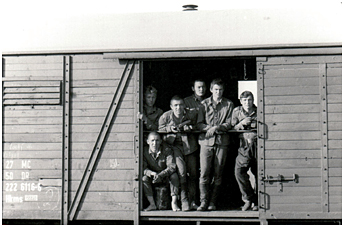 Un train de conscrits dans les environs de Berlin-Est en 1984. © H.Black.
Un train de conscrits dans les environs de Berlin-Est en 1984. © H.Black.
A boxcar loaded with conscripts near East-Berlin in 1984. © H.Black.
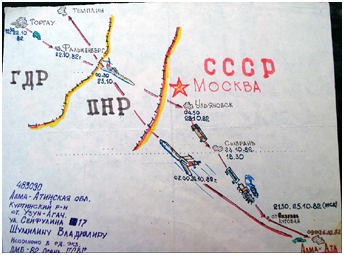 The GSFG rotated approximately one-quarter to one-third of its personnel twice a year, in the spring and in the fall. Until the early-1970s,
these troops were transported via train into and out of the Soviet Zone of Occupation. Such trains usually comprised about 40 cars: an engine,
a coal car, 32-34 boxcars for personnel and the remainder for baggage and supplies. The boxcars were the old German M-wagens (Menschwagen - people cars)
equipped with two wide wooden shelves serving as bunks, a charcoal space heater and a potty chair. These were rudimentary transportation assets to say the least.
Twice a year the allied liaison missions mounted a special operation to monitor the main GDR rail lines. Reconnaissance tours would spend several days in a well-chosen
OP watching for troop rotation trains. These tours would be replaced on a scheduled basis to provide 24-hour-a-day saturation coverage. This was not exciting work, but
there was a continuing requirement from higher headquarters for such reporting so an estimate could be made of what percentage of the force was rotating.
In the early-1970s, the troop rotation mode of transportation changed. Civilian airliners with Aeroflot markings began to be used. Highly sensitive collection programs
provided information on this change of procedures, but the level of distribution of this information necessarily was limited.
The GSFG rotated approximately one-quarter to one-third of its personnel twice a year, in the spring and in the fall. Until the early-1970s,
these troops were transported via train into and out of the Soviet Zone of Occupation. Such trains usually comprised about 40 cars: an engine,
a coal car, 32-34 boxcars for personnel and the remainder for baggage and supplies. The boxcars were the old German M-wagens (Menschwagen - people cars)
equipped with two wide wooden shelves serving as bunks, a charcoal space heater and a potty chair. These were rudimentary transportation assets to say the least.
Twice a year the allied liaison missions mounted a special operation to monitor the main GDR rail lines. Reconnaissance tours would spend several days in a well-chosen
OP watching for troop rotation trains. These tours would be replaced on a scheduled basis to provide 24-hour-a-day saturation coverage. This was not exciting work, but
there was a continuing requirement from higher headquarters for such reporting so an estimate could be made of what percentage of the force was rotating.
In the early-1970s, the troop rotation mode of transportation changed. Civilian airliners with Aeroflot markings began to be used. Highly sensitive collection programs
provided information on this change of procedures, but the level of distribution of this information necessarily was limited.
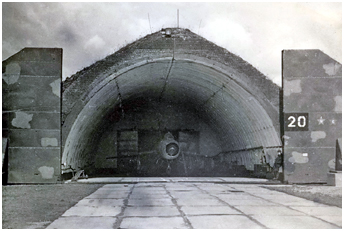
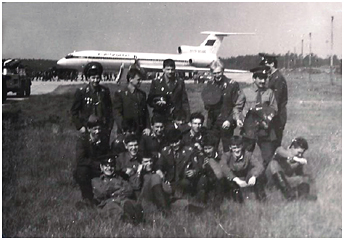 Des soldats heureux à l'issue de leur seconde année de service au sein du 787.IAP. Ils attendent d'embarquer
à bord d'un Tu-154 à destination de la Mère patrie (Finow, 1989). © V.Glouchkov.
Des soldats heureux à l'issue de leur seconde année de service au sein du 787.IAP. Ils attendent d'embarquer
à bord d'un Tu-154 à destination de la Mère patrie (Finow, 1989). © V.Glouchkov.
These happy soldiers have completed their two years service duty within the 787.IAP. They are waiting to embark aboard a
Tu-154 bound for the Motherland (Finow, 1989). © V.Glushkov.
The USMLM Air Team could prove this to be true and report this fact at the CONFIDENTIAL level, this would allow much wider dissemination of this information.
One of the troop rotation airfields was Grossenhain Soviet Airfield, home of the 497th Fighter-Bomber Aviation Regiment (497.IBAP) equipped with Su-7 (FITTER A) ground-attack aircraft.
Nick Netter and I were assigned to monitor this airfield on November 7, 1972, a cold foggy late fall day. Visibility was not very good, but we used this lousy weather to
our advantage. We succeeded in getting to our OP unobserved and were confident no one knew where we were. It was quite early in the morning, around 7 a.m. as I recall, and
there was little or no traffic, nor was there any other activity. In addition, this was a Soviet holiday, the 55th anniversary of the Russian Revolution, after all!
We had worked our way to an OP to the northeast of the airfield. We were in a copse of
woods very close to the airfield perimeter fence, which provided an unimpeded view of the airfield parking ramp.
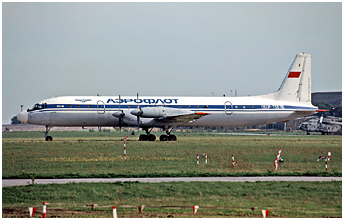
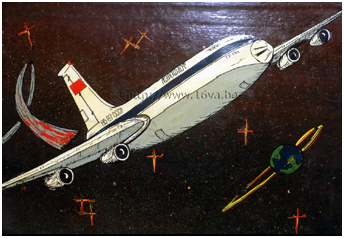 Nick positioned the vehicle perfectly at the fence, which allowed me to get
pictures of a long line of troops, in uniform, climbing the steps to board a civilian IL-18 aircraft
with Aeroflot markings. This was the confirmation we needed, but only if the photography was
usable. The conditions were very poor: low level of light and some ground fog. Our photo lab
technicians had their work cut out for them because I had exposed my Kodak Tri-X film (rated
at ASA 400) at 6400 ASA.
Fortunately, we had just the right person to cope with this task. Technical Sergeant Ken Rocheleau
was a key member of the USMLM Photo Lab. He had recently completed a tour of duty
at the US Embassy in Moscow. Ken had developed certain special techniques for handling critical
film and his results always were spectacular.
In this instance, he pre-soaked the film prior to processing, and then processed the film carefully
using special time and temperature procedures he had devised and perfected. Even though
the conditions under which I had exposed the Grossenhain film were very bad, Ken produced
prints that clearly verified what Nick Netter and I had observed visually. We had our confirmation.
As the 1972 USMLM Unit History puts it: "This sighting served to remove almost all
doubt about the involvement of Aeroflot aircraft in the GSFG troop rotation program."
Nick positioned the vehicle perfectly at the fence, which allowed me to get
pictures of a long line of troops, in uniform, climbing the steps to board a civilian IL-18 aircraft
with Aeroflot markings. This was the confirmation we needed, but only if the photography was
usable. The conditions were very poor: low level of light and some ground fog. Our photo lab
technicians had their work cut out for them because I had exposed my Kodak Tri-X film (rated
at ASA 400) at 6400 ASA.
Fortunately, we had just the right person to cope with this task. Technical Sergeant Ken Rocheleau
was a key member of the USMLM Photo Lab. He had recently completed a tour of duty
at the US Embassy in Moscow. Ken had developed certain special techniques for handling critical
film and his results always were spectacular.
In this instance, he pre-soaked the film prior to processing, and then processed the film carefully
using special time and temperature procedures he had devised and perfected. Even though
the conditions under which I had exposed the Grossenhain film were very bad, Ken produced
prints that clearly verified what Nick Netter and I had observed visually. We had our confirmation.
As the 1972 USMLM Unit History puts it: "This sighting served to remove almost all
doubt about the involvement of Aeroflot aircraft in the GSFG troop rotation program."
Bill Burhans
| USMLM Unit History, 1972 GSFG TROOP ROTATION GENERAL:
SPRING ROTATION: FALL ROTATION: |
Never judge by appearances
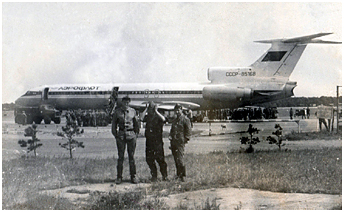
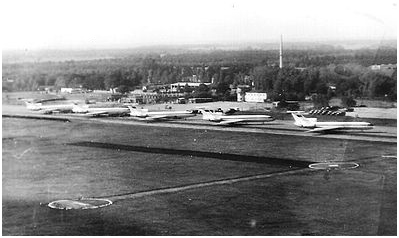 Pas moins de cinq Tu-154 de l'Aeroflot en escale à Parchim au cours des années quatre-vingt. © A.Vinogradov.
Pas moins de cinq Tu-154 de l'Aeroflot en escale à Parchim au cours des années quatre-vingt. © A.Vinogradov.
No less than five Tu-154 from the Aeroflot can be counted on this picture taken at Parchim during the 1980s. © A.Vinogradov.
While it seems certain that civilian airliners were called in to assist the troop rotation between airports located in various parts of the USSR and East Germany,
it is necessary to get things straigth in order to dispel a myth that dies hard.
Those of us who lived the Cold War know the story: "Aeroflot aircraft flew for the military and they were all military anyway..."
This fable that is still alive nowadays was based on misleading factual observation (the above story being a good exemple) or peremptory judgment about
the "Soviet way of life."
As a matter of fact, except for large-scale operations such as the troop rotation of conscripts, aircraft in "Aeroflot" markings flying missions for the military
were military aircraft on strength with military units; they were based on military
airfields and they were flown by military personnel! (1)
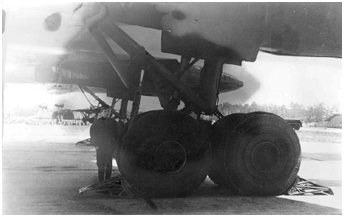
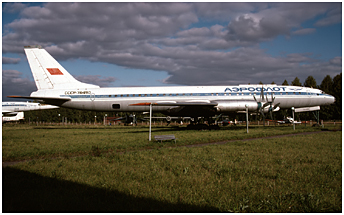 Many of the airliners observed in the GDR, were stationed at Chkalovskiy military airfield, located ENE of Moscow.
One of the units stationed at this airbase was the 10th Separate Red Banner Special-Purpose Aviation Brigade (10-ya Otdelnaya
Krasnoznamennaya Aviatsionnaya Brigada Osobogo Naznacheniya - 10.OABON) established on June 1, 1960. Military airliners that were flying to and from the
"fraternal countries" were on strength with this unit (2) - the brigade comprised eight squadrons
in 1978. The latter was absorbed by the 8th Red Banner Special-Purpose Aviation Division (8-ya Aviatsionnaya Krasnoznamennaya Diviziya Osobogo Naznacheniya -
8.ADON) on December 31, 1981. The subordination of this unit changed after the fall of the USSR. The aircraft concerned in this article were incorporated into the 223rd
Flight Detachment (223-iy Letnyy Otryad) and now they are flying for the benefit of both military and civilian entities.
Many of the airliners observed in the GDR, were stationed at Chkalovskiy military airfield, located ENE of Moscow.
One of the units stationed at this airbase was the 10th Separate Red Banner Special-Purpose Aviation Brigade (10-ya Otdelnaya
Krasnoznamennaya Aviatsionnaya Brigada Osobogo Naznacheniya - 10.OABON) established on June 1, 1960. Military airliners that were flying to and from the
"fraternal countries" were on strength with this unit (2) - the brigade comprised eight squadrons
in 1978. The latter was absorbed by the 8th Red Banner Special-Purpose Aviation Division (8-ya Aviatsionnaya Krasnoznamennaya Diviziya Osobogo Naznacheniya -
8.ADON) on December 31, 1981. The subordination of this unit changed after the fall of the USSR. The aircraft concerned in this article were incorporated into the 223rd
Flight Detachment (223-iy Letnyy Otryad) and now they are flying for the benefit of both military and civilian entities.
The airliner types were painted in full Aeroflot livery. Some military cargo aircraft like the An-22 were almost exclusively
available in "Aeroflot" markings. Also, you will have a hard time finding a VTA Il-76 with a red star on its tail, although a few do exist.
Some other types like the An-12 (3)
could be camouflaged but still had "Aeroflot" markings and civilian registration.
Military aircraft adorned with civilian markings could travel abroad more easily. During the Six-Days War in 1967,
an airlift was set up to support the Arab states. The cargo planes that took part did so under civilian liveries with a red flag
on the tail instead of a red star. This approach later prevailed in the communist countries, although on a much lower scale.
Airborne command posts also kept their "Aeroflot" markings (see the paragraph entitled
"Airborne Command Posts" in Part 3 of the "Transport & Sperenberg" chapter > Link).
The civilian colour scheme or markings of military
aircraft could be considered a sort of camouflage or a deception plan. And, it worked quite well indeed in the West! Of course, some cargo aircraft also bore military
markings, but often they had previously "Aeroflot" markings. Undoubtedly, this maskirovka (disguise or deception) operation was a big success!
Nowadays, the "Aeroflot" markings have disappeared; however, the basic pattern of white, gray and blue remained. During the traditional Victory Parade that was held
in Moscow on May 9, 2014, the An-124 and the three Il-76MD that participated in the flyover above
Red Square had a red star instead of the Russian flag hastily painted on their vertical empennage.
The rest of the VTA fleet now seems to slowly follow this new trend.
Hugo Mambour
 |
VTA PHOTO PAGE |
notes
(1)
There are no rules without exceptions. For example, some aircraft in service with Aeroflot were transferred to the VVS (read the captions of the two
Tu-114 pictures at the end of this article). Their civilian career was followed by a military career.
That seems to have been the case with older
aircraft (such as the Tu-114s) and/or those that were assigned in small numbers to the military.
However, most of the VVS airliner and transport
aircraft have been in military service since the very beginning.
(2)
These are the same aircraft that carried out liaison flights to former airfields in East Germany, including Sperenberg, after the fall of the Berlin Wall.
(3)
"At the factory, most military An-12s received a "quasi-civilian" paint scheme simulating their belonging to Aeroflot."
(From Aviatsiya i Kosmonavtika, July 2010).
However, pictures and videos taken during the early sixties show An-12s in natural metal finish
with full military markings. Also, the first An-22s had
military markings. Therefore, it appears that the "Aeroflot camouflage" scheme was introduced
after the mid-sixties. The decision probably followed
the Six-Days War in 1967 when an airlift was set up to supply the Arab states,
as the aircraft taking part to it were disguised in civilian markings.
 |
Plan du site - Sitemap |  |

